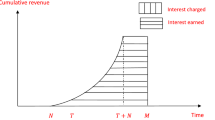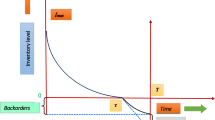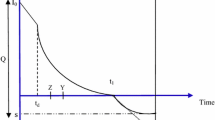Abstract
In general, the demand rate moving through a product life cycle can be reasonably depicted by a trapezoidal-type pattern: it initially increases during the introduction and growth phases, then remains reasonably constant in the maturity phase, and finally decreases in the decline phase. It is evident that perishable products deteriorate continuously over time and can not be sold after its maximum lifetime. Thus, the deterioration rate of a product is increasing with time and closely related to its maximum lifetime. Furthermore, it has been hard to obtain loans from banks since the global financial meltdown in 2008. Hence, over 80% of firms in the United Kingdom and the United States sell their products on various short-term, interest-free loans (i.e., trade credit) to customers. To incorporate those important facts, we develop an inventory model by (1) assuming the demand pattern is trapezoidal, (2) extending the deterioration rate to 100% as its maximum lifetime is approaching, (3) using discounted cash-flow analysis to calculate all relevant costs considering the effects of upstream and downstream trade credits, and (4) including the costly purchase cost into the total cost, which is omitted in previous studies. Then, the order quantity that maximizes the present value of the profit is uniquely determined. Finally, through numerical examples, managerial insights are provided.






Similar content being viewed by others
References
Ahmed, M. A., Ai-Khamis, T. A., & Benkherouf, L. (2013). Inventory models with ramp type demand rate, partial backlogging and general deterioration rate. Applied Mathematics and Computation, 219, 4288–4307.
Avinadav, T., Chernonog, T., Lahav, Y., & Spiegel, U. (2017). Dynamic pricing and promotion expenditures in an EOQ model of perishable products. Annals of Operations Research, 248, 75–91.
Cárdenas-Barrón, L. E., Chung, K.-J., & Treviño-Garza, G. (2014). Celebrating a century of the economic order quantity model in honor of Ford Whitman Harris. International Journal of Production Economics, 155, 1–7.
Cheng, M., & Wang, G. (2009). A note on the inventory model for deteriorating items with trapezoidal type demand rate. Computers & Industrial Engineering, 56, 1296–1300.
Cheng, M., Zhang, B., & Wang, G. (2011). Optimal policy for deteriorating items with trapezoidal type demand and partial backlogging. Applied Mathematical Modelling, 35, 3552–3560.
Chen, S.-C., & Teng, J.-T. (2014). Retailer’s optimal ordering policy for deteriorating items with maximum lifetime under supplier’s trade credit financing. Applied Mathematical Modelling, 38, 4049–4061.
Chen, S.-C., & Teng, J.-T. (2015). Inventory and credit decisions for time-varying deteriorating items with up-stream and down-stream trade credit financing by discounted cash-flow analysis. European Journal of Operational Research, 243, 566–575.
Das, D., Roy, A., & Kar, S. (2015). A multi-warehouse partial backlogging model for deteriorating items under inflation when a delay in payment is permissible. Annals of Operations Research, 226, 133–162.
Dave, U. (1989). A deterministic lot-size inventory model with shortages and a linear trend in demand. Naval Research Logistics, 36, 507–514.
Donaldson, W. A. (1977). Inventory replenishment policy for a linear trend in demand: An analytical solution. Operational Research Quarterly, 28, 663–670.
Dye, C.-Y., Yang, C.-T., & Kung, F.-C. (2014). A note on: Seller’s optimal credit period and cycle time in a supply chain for deteriorating items with maximum lifetime. European Journal of Operational Research, 239, 868–871.
Feng, L., Chan, Y.-L., & Cárdenas-Barrón, L. E. (2017). Pricing and lot-sizing policies for perishable goods when the demand depends on selling price, displayed stocks, and expiration date. International Journal of Production Economics, 185, 11–20.
Ghoreishi, M., Weber, G. W., & Mirzazadeh, A. (2015). An inventory model for non-instantaneous deteriorating items with partial backlogging, permissible delay in payment, inflation- and selling price-dependent demand and customer returns. Annals of Operations Research, 226, 221–238.
Giri, B. C., Jalan, A. K., & Chaudhuri, K. S. (2003). Economic order quantity model with Weibull deterioration distribution, shortages and ramp type demand. International Journal of Systems Science, 34, 237–243.
Goyal, S. K. (1985). Economic order quantity under conditions of permissible delay in payments. Journal of the Operational Research Society, 36, 335–338.
Harris, F. W. (1913). How many parts to make at once. Factory, the Magazine of Management, 10, 135–136.
Hill, R. M. (1995). Inventory models for increasing demand followed by level demand. Journal of the Operational Research Society, 46, 1250–1259.
Huang, Y. F. (2003). Optimal retailer’s ordering policies in the EOQ model under trade credit financing. Journal of the Operational Research Society, 54, 1011–1015.
Lashgari, M., Taleizadeh, A. A., & Sana, S. S. (2016). An inventory control problem for deteriorating items with back-ordering and financial considerations under two levels of trade credit linked to order quantity. Journal of Industrial and management optimization, 12(3), 1091–1119.
Lin, J., Hung, K.-C., & Julian, P. (2014). Technical note on inventory model with trapezoidal type demand. Applied Mathematical Modelling, 38, 4941–4948.
Mandal, B., & Pal, A. K. (1998). Order level inventory system with ramp type demand rate for deteriorating items. Journal of Interdisciplinary Mathematics, 1, 49–66.
Roy, A., Sana, S. S., & Chaudhurt, K. S. (2016). Joint decision on EOQ and pricing strategy of a dual channel of mixed retail and e-tail comprising of single manufacturer and retailer under stochastic demand. Computers & Industrial Engineering, 102, 423–434.
Sana, S. S. (2008). An EOQ model with a varying demand followed by advertising expenditure and selling price under permissible delay in payments: for a retailer. International Journal of Modelling, Identification and Control, 5(2), 166–172.
Sana, S. S. (2010). Optimal selling price and lotsize with time varying deterioration and partial backlogging. Applied Mathematics and Computation, 217(1), 185–194.
Sana, S. S. (2015). An EOQ model for stochastic demand for limited capacity of own warehouse. Annals of Operations Research, 233(1), 383–399.
Sana, S. S., & Chaudhurt, K. S. (2008). A deterministic EOQ model with delays in payments and price-discount offers. European Journal of Operational Research, 184(2), 509–533.
Sana, S. S., & Goyal, S. K. (2015). (Q, r, L) model for stochastic demand with lead-time dependent partial backlogging. Annals of Operations Research, 233(1), 401–410.
Sarkar, B., Saren, S., & Cárdenas-Barrón, L. E. (2015). An inventory model with trade-credit policy and variable deterioration for fixed lifetime products. Annals of Operations Research, 229, 677–702.
Seifert, D., Seifert, R. W., & Protopappa-Sieke, M. (2013). A review of trade credit literature: Opportunity for research in operations. European Journal of Operational Research, 231, 245–256.
Skouri, K., & Konstantaras, I. (2009). Order level inventory models for deteriorating seasonable/fashionable products with time dependent demand and shortages. Mathematical Problems in Engineering, 2009, 679736.
Skouri, K., Konstantaras, I., Papachristos, S., & Ganas, I. (2009). Inventory model with ramp type demand rate, partial backlogging and Weibull deterioration rate. European Journal of Operational Research, 192, 79–92.
Skouri, K., & Papachristos, S. (2002). A continuous review inventory model, with deteriorating items, time-varying demand, linear replenishment cost, partially time-varying backlogging. Applied Mathematical Modelling, 26, 603–617.
Teng, J.-T. (2002). On the economic order quantity under conditions of permissible delay in payments. Journal of the Operational Research Society, 53, 915–918.
Teng, J.-T., Cárdenas-Barrón, L. E., Chang, H.-J., Wu, J., & Hu, Y. (2016). Inventory lot-size policies for deteriorating items with expiration dates and advance payments. Applied Mathematical Modelling, 40(19–20), 8605–8616.
Teng, J.-T., Chang, H.-J., Dye, C.-Y., & Hung, C.-H. (2002). An optimal replenishment policy for deteriorating items with time-varying demand and partial backlogging. Operations Research Letters, 30, 387–393.
Teng, J.-T., Chern, M.-S., Yang, H.-L., & Wang, Y.-J. (1999). Deterministic lot-size inventory models with shortages and deterioration for fluctuating demand. Operations Research Letters, 24, 65–72.
Teng, J. T., & Goyal, S. K. (2007). Optimal ordering policies for a retailer in a supply chain with up-stream and down-stream trade credits. Journal of the Operational Research Society, 58, 1252–1255.
Teng, J.-T., & Yang, H.-L. (2004). Deterministic economic order quantity models with partial backlogging when demand and cost are fluctuating with time. Journal of the Operational Research Society, 55, 495–503.
Wang, C., & Huang, R. (2014). Pricing for seasonal deteriorating products with price- and ramp-type time-dependent demand. Computers & Industrial Engineering, 77, 29–34.
Wang, W.-C., Teng, J.-T., & Lou, K.-R. (2014). Seller’s optimal credit period and cycle time in a supply chain for deteriorating items with maximum lifetime. European Journal of Operational Research, 232, 315–321.
Wu, K.-S. (2001). An EOQ inventory model for items with Weibull distribution deterioration, ramp type demand rate and partial backlogging. Production Planning and Control, 12, 787–793.
Wu, J., Al-khateeb, F. B., Teng, J. T., & Cárdenas-Barrón, L. E. (2016). Inventory models for deteriorating items with maximum lifetime under downstream partial trade credits to credit-risk customers by discounted cash-flow analysis. International Journal of Production Economics, 171(Part 1), 105–115.
Wu, J., & Chan, Y.-L. (2014). Lot-sizing policies for deteriorating items with expiration dates and partial trade credit to credit-risk customers. International Journal of Production Economics, 155, 292–301.
Wu, J.-W., Lin, C., Tan, B., & Lee, W.-C. (1999). An EOQ inventory model with ramp type demand rate for items with Weibull deterioration. International Journal of Information and Management Sciences, 10, 41–51.
Wu, J., Ouyang, L.-Y., Cárdenas-Barrón, L. E., & Goyal, S. K. (2014). Optimal credit period and lot size for deteriorating items with expiration dates under two-level trade credit financing. European Journal of Operational Research, 237, 898–908.
Acknowledgements
The authors deeply appreciate Editor-in-Chief Endre Boros and three anonymous reviewers for their suggestions which significantly improve the paper.
Author information
Authors and Affiliations
Corresponding author
Rights and permissions
About this article
Cite this article
Wu, J., Teng, JT. & Skouri, K. Optimal inventory policies for deteriorating items with trapezoidal-type demand patterns and maximum lifetimes under upstream and downstream trade credits. Ann Oper Res 264, 459–476 (2018). https://doi.org/10.1007/s10479-017-2673-2
Published:
Issue Date:
DOI: https://doi.org/10.1007/s10479-017-2673-2




